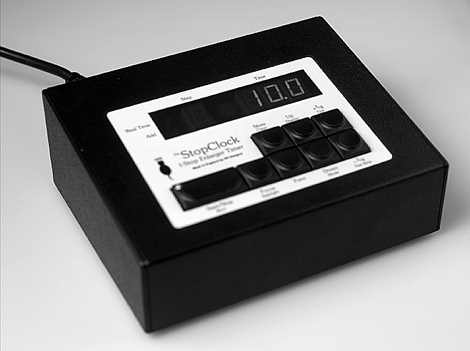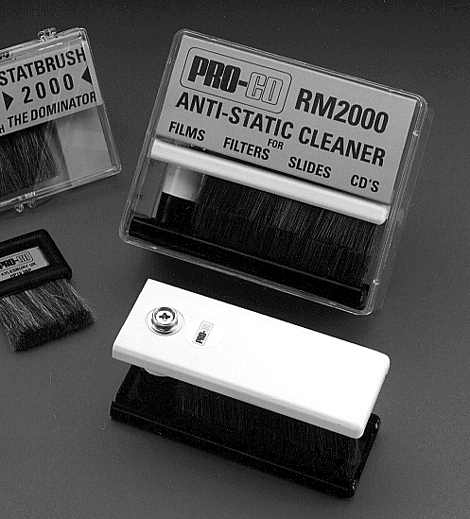

Precision has always been a prerequisite in fine print making and the technology of the day has always provided a means of maintaining that requirement. Therefore, precision is the theme of this month's column, where we will evaluate various ways of helping and improving the control required in the search for the elusive fine print.
I cannot recall the exact reply, but it would have been short and to the point. Well, that photographer has now put me on the spot by sending me Stop Clock, the f-Stop Enlarger Timer, marketed by his own company RH Designs.

Stop Clock is an electronic enlarger timer which can be used as a conventional timer in real time mode or as an f-stop timer for those who prefer that method. The timer is easily connected to any enlarger simply by fitting the plug supplied. There is also provision to fit a similar plug to the darkroom safelight should you require it. The unit is very compact, the display is easily seen in the darkroom, and it is best operated by the optional footswitch which plugs into the back of the timer. It can be operated by pressing the button on the display panel, but this means that you don't have hands free operation.
In addition to the stop/start and focus keys, there are six other keys which control the options offered by the timer. RH Designs provide a short but comprehensive manual on the various functions offered by this f-stop timer and it is worth while spending a little time reading it to familiarise yourself with its functions. When first confronted with this sort of technology, it is natural to be a little confused and apprehensive about the apparent complexity. Twenty minutes with the manual following the examples given will remove any doubts or fears.
I started using the Stop Clock in the conventional way, simply making my test-strip as I always have done. The time can be set in tenths of one second up to 25.5 seconds, and up to 255 seconds in one second intervals thereafter.
I found the timer easy to use and consistent in that if I made test strips at three second intervals, six three second exposures produced the same density of tone as one at eighteen second exposure.
I then started to use the timer in f-stop mode where it allows increases in quarter-stop intervals. In the test strip mode the timer allows up to ten increments on one strip and in operation, the timer pauses in between each step and the digital display counts the number of steps. The method is to select the shortest desired exposure and increase it in up to ten quarter-stop increments. To make a print from the test strip select the increment that you consider correctly exposed, say the third step. This represents base exposure plus 1/2 stop, to set this time press the +1/4 stop button twice and Stop Clock automatically calculates the correct exposure.
Complicated burning and dodging exposures can be dealt with by putting the timer into program mode where up ten different procedures can be input. I made prints using three different exposures in addition to the base exposure, and found the operation very simple. To test reproducibility, I made the same print several times and found them all to be exactly the same.
The Stop Clock Timer is an impressive piece of precision darkroom equipment. I had never used the �-stop method of exposure before carrying out this test but I found no problems with the timer or the method of exposure. After a few exposures had been made, during which time reference to the manual was frequent, I soon was able to program the timer with ease.
My one criticism is that the footswitch is light in weight and not well balanced, in that it tends to creep about the floor of the darkroom. This can be frustrating when you have to feel around the floor with your foot to locate the switch. It is a small but important point and I do know that more substantial switches are available.
At �160 pounds GB including VAT Stop Clock represents good value for money and should prove to be a valuable and practical addition to any darkroom. In his letter to Photon when he sent the timer, Dr Richard Ross of RH Designs also recalled our meeting and wondered if Stop Clock can convert me to this method of timing exposures. My answer is that it has gone a long way toward that, and has given me food for serious thought.
The construction is similar to a microscope, and includes an 86mm mirror which allows access to all areas of the image projected on to the base board. This enables the sharpness in all corners to be accurately checked. The loupe portion is arranged to allow swinging which also helps to see into the corners of the image.
Model 2000 is supplied with a blue filter which is reported to give better focus sharpness when working with graded papers, which are blue-sensitive. In practice I find that the image on the base board is difficult to see, and I use multi-graded papers, so I find no benefit in using it.
The Peak Enlarging Focuser is a precision item which I have found to be a great asset in my darkroom. Whilst on the subject of precision and focusing, one small point that can have a bearing on the sharpness of a finished print is that enlarging lenses can shift in focus as they are stopped down. Therefore, while I always focus with the lens open, I also check the focus at the chosen exposure aperture.
At Focus on Imaging '95 I purchased a very useful little gadget made by Process Control Company - the RM 2000 Anti Static Cleaner, simple in design and very easy and effective in use.

The RM 2000 has two soft brushes placed facing inwards on top of and touching each other. The unit is about four inches long and fixes to any surface with sticky fixers which are supplied. The negative is drawn slowly through the brushes a couple of times before printing.
I have found it to be very effective in cleaning even old negatives where I thought that the blemishes were stuck to the negative. I had previously used brushes and cans of dust-off to no avail, but the Pro-Co RM 2000 removed a considerable amount of the offending dust. For the modest investment of �25 you can save yourself a lot of time and frustration.
So instead of worrying about the effect that electronics may have on traditional photography we should perhaps celebrate the fact that we can always benefit from the spin-off in accessories, optical quality, and even anti-static control devices.
Stop Clock Timer is supplied by; RH Designs, 7 Panxworth Road, Hemel Hempstead, Herts HP3 9HQ, UK. Telephone (+44) 01438 362228.
Pro-Co RM 2000 supplied by; Process Control Company, Aylesbury, Bucks HP19 3BP, UK. Telephone (+44) 01296 84877.
The Peak focus finder range is from branches of KJP (Calumet in the USA).